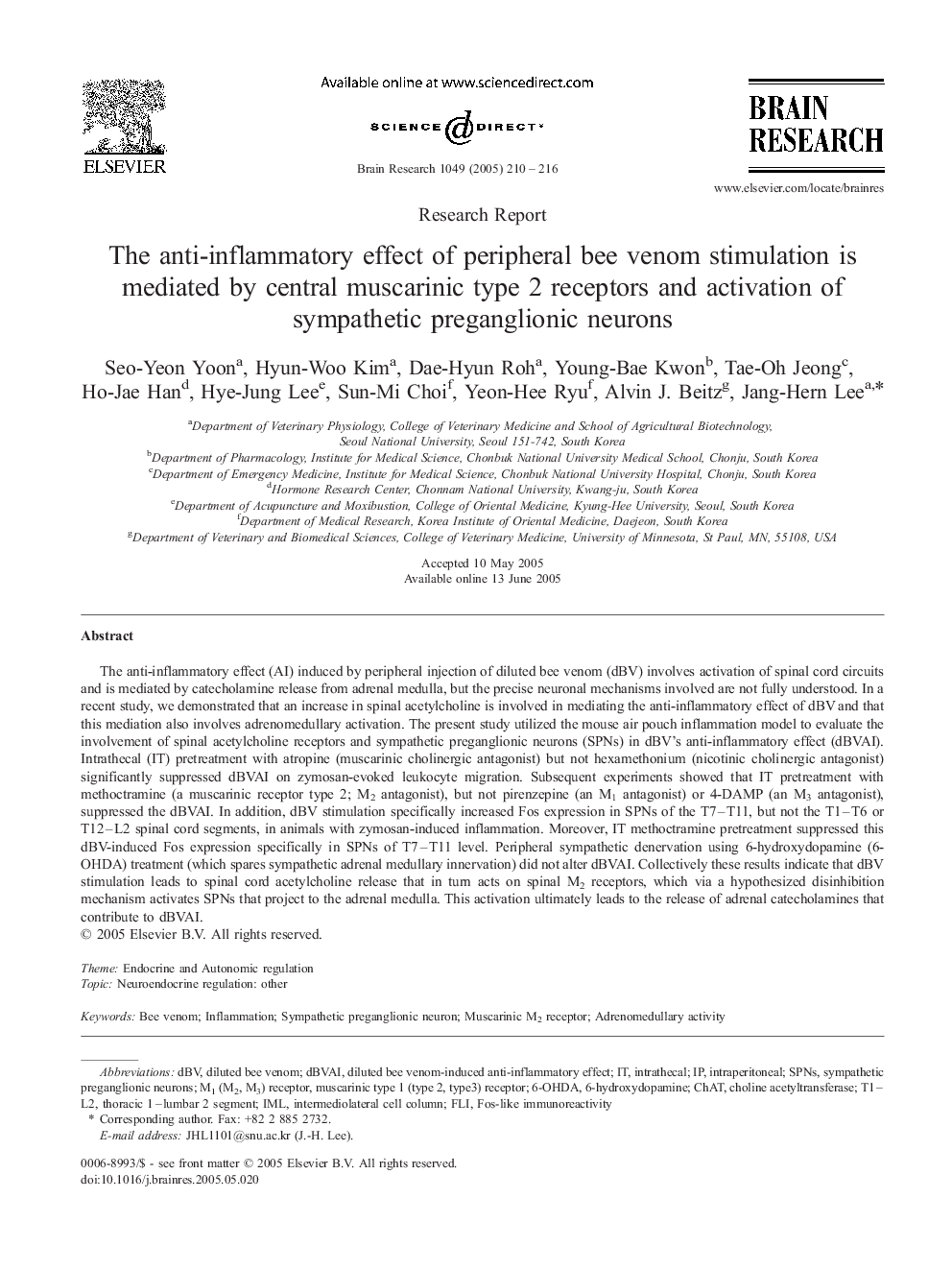| کد مقاله | کد نشریه | سال انتشار | مقاله انگلیسی | نسخه تمام متن |
|---|---|---|---|---|
| 9416159 | 1292959 | 2005 | 7 صفحه PDF | دانلود رایگان |
عنوان انگلیسی مقاله ISI
The anti-inflammatory effect of peripheral bee venom stimulation is mediated by central muscarinic type 2 receptors and activation of sympathetic preganglionic neurons
دانلود مقاله + سفارش ترجمه
دانلود مقاله ISI انگلیسی
رایگان برای ایرانیان
کلمات کلیدی
6-HydroxydopamineIMLFLI6-OHDASPNsDBVinflammation - التهاب( توروم) Fos-like immunoreactivity - ایمونوفیزیک Fos مانندintrathecal - اینتراکتالEndocrine and autonomic regulation - تنظیم غدد درون ریز و اتونومیکNeuroendocrine regulation: other - تنظیم نوروآندوکرین: دیگرintraperitoneal - داخل صفاقیBee venom - زهر زنبور عسلintermediolateral cell column - ستون سلول میان سلولیSympathetic preganglionic neuron - نورون پروژنگولی سمپاتیکSympathetic preganglionic neurons - نورونهای پیشگنگلیونی سمپاتیکChAT - چتcholine acetyltransferase - کولین استیل ترانسفرازMuscarinic M2 receptor - گیرنده M2 مسکارینیک
موضوعات مرتبط
علوم زیستی و بیوفناوری
علم عصب شناسی
علوم اعصاب (عمومی)
پیش نمایش صفحه اول مقاله

چکیده انگلیسی
The anti-inflammatory effect (AI) induced by peripheral injection of diluted bee venom (dBV) involves activation of spinal cord circuits and is mediated by catecholamine release from adrenal medulla, but the precise neuronal mechanisms involved are not fully understood. In a recent study, we demonstrated that an increase in spinal acetylcholine is involved in mediating the anti-inflammatory effect of dBV and that this mediation also involves adrenomedullary activation. The present study utilized the mouse air pouch inflammation model to evaluate the involvement of spinal acetylcholine receptors and sympathetic preganglionic neurons (SPNs) in dBV's anti-inflammatory effect (dBVAI). Intrathecal (IT) pretreatment with atropine (muscarinic cholinergic antagonist) but not hexamethonium (nicotinic cholinergic antagonist) significantly suppressed dBVAI on zymosan-evoked leukocyte migration. Subsequent experiments showed that IT pretreatment with methoctramine (a muscarinic receptor type 2; M2 antagonist), but not pirenzepine (an M1 antagonist) or 4-DAMP (an M3 antagonist), suppressed the dBVAI. In addition, dBV stimulation specifically increased Fos expression in SPNs of the T7-T11, but not the T1-T6 or T12-L2 spinal cord segments, in animals with zymosan-induced inflammation. Moreover, IT methoctramine pretreatment suppressed this dBV-induced Fos expression specifically in SPNs of T7-T11 level. Peripheral sympathetic denervation using 6-hydroxydopamine (6-OHDA) treatment (which spares sympathetic adrenal medullary innervation) did not alter dBVAI. Collectively these results indicate that dBV stimulation leads to spinal cord acetylcholine release that in turn acts on spinal M2 receptors, which via a hypothesized disinhibition mechanism activates SPNs that project to the adrenal medulla. This activation ultimately leads to the release of adrenal catecholamines that contribute to dBVAI.
ناشر
Database: Elsevier - ScienceDirect (ساینس دایرکت)
Journal: Brain Research - Volume 1049, Issue 2, 12 July 2005, Pages 210-216
Journal: Brain Research - Volume 1049, Issue 2, 12 July 2005, Pages 210-216
نویسندگان
Seo-Yeon Yoon, Hyun-Woo Kim, Dae-Hyun Roh, Young-Bae Kwon, Tae-Oh Jeong, Ho-Jae Han, Hye-Jung Lee, Sun-Mi Choi, Yeon-Hee Ryu, Alvin J. Beitz, Jang-Hern Lee,